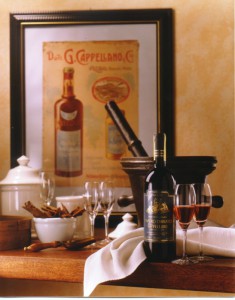 If you love Italian wine, you can most likely discuss the intricacies of Brunello, Barbaresco, and Bardolino. If you love Italian food, you probably crave Bolognese, Balsamic, and Burrata on a daily basis. But what can you tell us about Barolo Chinato?
If you love Italian wine, you can most likely discuss the intricacies of Brunello, Barbaresco, and Bardolino. If you love Italian food, you probably crave Bolognese, Balsamic, and Burrata on a daily basis. But what can you tell us about Barolo Chinato?
Don’t worry – you don’t have to give up your Italophile badge just yet. Barolo Chinato is rare – it’s not exactly easy to find in America, despite it being more widely available than ever these days, thanks to the longevity of the craft cocktail craze and an ever-growing American fondness for all things Italian.
Barolo Chinato is digestive (equally qualified to serve as aperitif) produced in Piedmont, Italy created from a base of Barolo wine. The word “china” (pronounced “key-na”) in Italian refers to “cinchona bark,” known to Americans as quinine. This, if we want to stay literal, Barolo Chinato (pronounced “key-not-o”) is Barolo wine that has been infused with quinine bark and other herbs and spices.
Technically, Barolo Chinato is considered a quinquina (an aperitif that contains cinchona bark) as well as an aromatized (flavored) wine. With alcohol levels of 16.5 – 18%, some versions of Barolo Chinato may also be considered a fortified wine, as some of the flavorings may be added in the form of extracts produced using alcohol.
 While the actual recipe of Chinato varies by producer and is a closely guarded secret, the flavorings are rumored to include sugar, rhubarb root, cinnamon, mint, vanilla, star anise, citrus peel, fennel, juniper, gentian root, and cardamom in addition to quinine. Don’t forget that all those layers of flavors are added to a base wine of Barolo – undisputedly one of Italy’s most complex wines to begin with. This is a smooth, spicy, flavorful sip with a hit of bitterness on the end – enough to wake up any appetite, or help smooth out an over-indulged one.
While the actual recipe of Chinato varies by producer and is a closely guarded secret, the flavorings are rumored to include sugar, rhubarb root, cinnamon, mint, vanilla, star anise, citrus peel, fennel, juniper, gentian root, and cardamom in addition to quinine. Don’t forget that all those layers of flavors are added to a base wine of Barolo – undisputedly one of Italy’s most complex wines to begin with. This is a smooth, spicy, flavorful sip with a hit of bitterness on the end – enough to wake up any appetite, or help smooth out an over-indulged one.
Barolo Chinato was first produced in the area around the city of Turin sometime in the 19th century. By this time, companies like Martini & Rossi and Cinzano were already producing Vermouth and other aperitifs in the region.
A Tuscan pastry chef named Giulio Cocchi is often cited as the inventor of Barolo Chinato. After moving to Asti, he was inspired by the region’s vermouth industry and founded his winery in 1891. Soon after, he invented a formula for Barolo Chinato. Dr. Giuseppe Cappellano is also believed by many to the Barolo Chinato’s creator. Dr. Cappellano was a pharmacist in Turin and the second son of the owner of the Cappellano Winery, which was founded in 1890.
Luckily, both companies are still around, and Barolo Chinato from both the Cappellano and Cocchi wineries are available in the United States. We may never decide who was first, you can decide for yourself who you think is best.
While the debate rages on, there are a few things that fans of Barolo Chinato can agree on: Barolo Chinato can help calm down a rumbly tummy after a hearty meal; it be used like an Amaro or Vermouth in a creative cocktail recipe, and it pairs very well with chocolate cake.
Cappellano Barolo Chinato: http://madrose.com/index.php/italy/piedmont/cappellano#barolo-chinato
Cocchi Barolo Chinato: http://www.cocchi.it/eng/barolo_chinato.htm